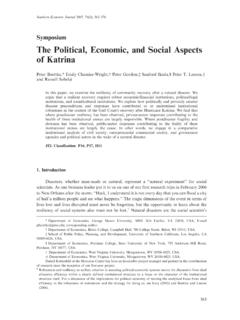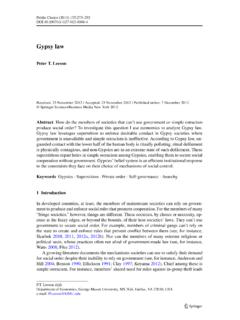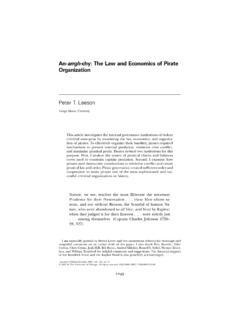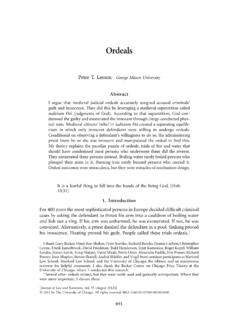Transcription of Government’s response to Hurricane Katrina: A …
1 Public Choice (2006)127:55 73 DOI: Springer 2006 government s response to Hurricane katrina : A public choiceanalysisRUSSELL S. SOBEL & PETER T. LEESOND epartment of Economics, West Virginia University, Morgantown, WV 26506-6025 (E-mail: use public choice theory to explain the failure of FEMA and other governmentalagencies to carry out effective disaster relief in the wake of Hurricane katrina . The areas inwhich we focus are: (1) the tragedy of the anti-commons resulting from layered bureaucracy,(2) a type-two error policy bias causing over cautiousness in decision making, (3) the politicalmanipulation of disaster declarations and relief aid to win votes, (4) the problem of acquiringtimely and accurate preference revelations, (5) glory seeking by government officials, and (6)the shortsightedness effect causing a bias in governmental decision : Flirting with Disaster As we are all aware, disasters are very political events.)
2 1 These words couldhave easily come from a public choice scholar, but instead were spoken bythen-FEMA Director James Lee Witt when he testified before Congress aboutthe cause of persistent problems and corruption in government disaster man-agement back in 1996. Each major disaster brings yet another tale ofFEMA corruption and failure, and yet another Congressional investigationinto the problems in FEMA. The failures of FEMA, and of government disas-ter relief more generally, which occurred in the wake of Hurricane katrina in2005 are nothing new; identical problems manifested themselves after virtu-ally every previous major disaster. What was different this time, however, wasthe visibility and severity of the failure, and of the human suffering it most other disasters, the individuals who suffer as a result of these gov-ernment policy errors are geographically diffuse and harder to identify.
3 AfterKatrina, however, thousands of them were packed into places like the Super-dome, resulting in significantly larger media attention to these problems inFEMA and government disaster s failed response to Hurricane katrina is a classic case studyin the potential problems with government action identified by public choicetheory. The hallmark of the public choice approach that individual actorsin both the private and public sector are motivated by self-interest shedsconsiderable light on this failure. Like all other individuals, self-interestedpoliticians and bureaucrats respond to the incentives they face. The actions56and choices of these public sector agents in the wake of Hurricane Katrinacan be understood by a careful examination of their this paper we employ public choice theory to identify six problem-atic incentive structures confronted by government actors when managingthe disaster caused by Hurricane katrina .
4 These are: (1) the tragedy of theanti-commons resulting from government disaster management s layered bu-reaucracy, (2) a type-two error policy bias causing over cautiousness in thedecisions of government disaster management officials, (3) the political ma-nipulation of disaster declarations and relief aid (usually geographic manipu-lation) to win votes, (4) the problem of acquiring timely and accurate prefer-ence revelations by those in need, (5) glory seeking by government officialsattempting to secure the credit for assisting Hurricane victims, and (6) theshortsightedness effect causing a bias in governmental decision Tragedy Indeed: government Disaster response and the Tragedyof the Anti-CommonsThe private sector s response to Hurricane katrina was swift and effectivewhen compared to the government s response .
5 Companies like Wal-Mart,Home Depot, and State Farm Insurance made preparations for the impendingdisaster weeks before katrina hit, and were willing and able to bring resourcesto bear on the disaster area days before government agencies could manageto do so. government s recognition and response to katrina was confused,chaotic, and much slower. The widespread examples of successful privateactionin equivalent circumstancesafter katrina clearly demonstrate that thesegovernment failures were not endemic to the situation they were potentiallyavoidable under the right incentive agencies like FEMA suffer from a problem of too much gov-ernment oversight, which results in what Columbia Law professor MichaelHeller (1968) dubbed the tragedy of the anti-commons. The more widelyknown tragedy of the commons 2occurs when individuals have unlimited ac-cess to resources in the absence of well-defined property rights.
6 While Heller sterm may be somewhat of a misnomer, the problem he identifies, the tragedyof the anti-commons, occurs whentoo manyindividuals have the power ofexclusion veto power over the use of resources or decision making. Thetragedy of the anti-commons might be better called the tragedy of politicalcommons, occurring when too many individuals and groups have access tothe decision-making process with overlapping powers of this situation, action requires the permission of many different and of-ten unrelated individuals. When disaster relief is centralized and managed bygovernment, it necessarily becomes bureaucratized and subject to the anti-commons problem. government agencies like FEMA are created to overseeand administer relief. These agencies are in turn overseen by other government57agencies, each with their own internal bureaucracies, and so on.
7 Followingorganizational changes after 9/11, for example, FEMA was placed under theumbrella of the Department of Homeland Security, adding new political de-cision makers to the mix. At each of the levels of potential approval, the keypolitical decision maker involved may face different personal incentives thanthose above or below him, delaying action still further. The layers of bureau-cracy ultimately end at some key administrative figure, which in the case ofdisaster relief is the president, who must declare a disaster before FEMA each level of the bureaucratic process is a key political decision makerwho can stall the process, since his sign-off is required before any proposedaction can be considered at the next level of political decision making, whereyet another key political decision maker is asked to consider the same too many political decision makers along the way, each of whom haveveto power over the proposed action, it is easy for proposed action to getstalled, prevented from being undertaken, or to simply fall through the result of layered bureaucracy inherent to centralized decision makingis slow and delayed action.
8 As Louisiana Governor, Kathleen Blanco, com-plained in the context of Hurricane katrina , No one, it seems, even those atthe highest level, seems to be able to break through the bureaucracy. 3 Some-times, this slowness and difficulty of implementing change is desirable. Whenit comes to changes in the law, for instance, this slowness and stalling canhelp to create a stable and certain legal environment. In other cases, however,the tragedy of the anti-commons creates a true tragedy especially when itcomes to government agencies charged with the task of addressing emergencysituations, when a speedy reaction is , but perhaps ironically, the real success stories in the relief ef-fort following katrina therefore came from those who ignored FEMA, floutedthe bureaucratic decision-making process, and took action without Coast Guard, for example, began its helicopter rescue efforts with-out waiting for any other government agency s approval or coordination.
9 Itsefforts were so successful that the leader of the Coast Guard s campaign, ViceAdmiral Thad Allen, was chosen as the replacement when FEMA directorMichael Brown was removed from his duties. A Canadian search and rescueteam from Vancouver, without waiting for FEMA permission, arrived in NewOrleans days before any FEMA coordinated units, leading to slightly inaccu-rate but amusing media accounts of how the Royal Canadian Mounted Policebeat the government into New of the best examples of this is what we call the tale of two sheriffs: Sheriff Warren Evans of Wayne County, Michigan and Sheriff Dennis Randleof Carroll County, Indiana. Both sheriffs were eager to assist Hurricane victims,and both had control over the necessary resources. Sheriff Evans ignored bothFEMA and his governor s instructions to wait for FEMA approval and went to58 New Orleans with nine truckloads of supplies and 33 deputies to , on the other hand, followed procedure, was buried under mounds ofFEMA paperwork, and faced an un-navigable approval process.
10 He nevermade it to New , while some have argued that the placement of FEMA underthe Department of Homeland Security after 9/11 created a shift in prioritiesfrom planning for natural disasters to planning for terrorist attacks, analyzingthe issue from the perspective of public choice suggests that the problem withthis reorganization was that it added additional layers of bureaucratic all, the flooding of a major city through a terrorist attack on a dam orlevy was certainly a well known potential terror threat. And many potentialterrorist attacks could have resulted in the necessity of a major evacuation. It sthus hard to argue that the focus on terrorism somehow prevented the agencyfrom preparing for the flood and evacuation of New for Disaster: Type-Two Error Bias in government DisasterResponse FEMA is not going to hesitate at all in this storm.





